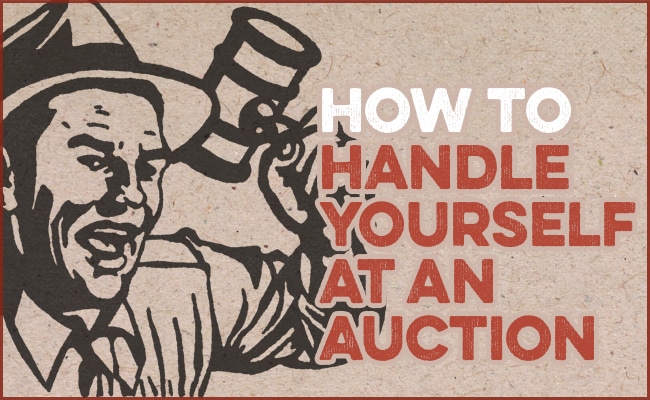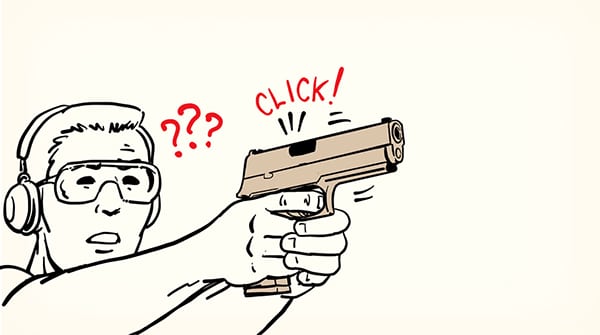
If you’re considering attending your first auction, you’re in for an experience. Auctions are not only a way to find unique items — sometimes for a steal — but also an opportunity to witness the purest form of free market capitalism. You get to see, in real time, the price of an object being decided by a group, and the atmosphere and dynamic can be pretty exciting to take part in.
Whether you’re attending a livestock, art, antique, or estate auction, understanding the etiquette and nuances of this kind of event can help you make the most of it. To walk us through the ins and outs of having a good auction experience, I talked to Ty Littau, a rancher who went to auctioneering school at Western College of Auctioneering (you probably didn’t know you can go to school for auctioneering, did you?) and runs livestock auctions throughout the year.
Preparing for the Auction
To make the most of an auction experience, it’s essential to come prepared. Ty recommends doing the following before you arrive at the auction. Here are some steps to take beforehand:
Do Some Research. Most auctions are “forward auctions”: the seller puts forth an item to buyers, and the buyers make bids. Highest bid wins.
While all auctions generally have the same format, Ty says you’ll notice subtle differences in the style and culture between them, depending on what’s being auctioned and where they take place. “How they do things at a livestock auction will be slightly different than how they do things in a fine art auction or an estate sale,” Ty says. “Auctions can even differ depending on your geography. Auctions have varying degrees of formality and informality. They’re small things, but it’s good to be aware of them before going.”
The internet is your friend. A lot of auctions post videos of their auctions on YouTube. Check out a few of those. They’re informative and fun to watch.
It’s also important to know whether absentee bidding – bidding by phone or the internet — is allowed during the auction. As Ty explained, “You gotta realize that even if there isn’t anyone standing next to you at the auction, there could be two or three people online bidding against you.”
Finally, research the type of items that will be available for bidding. An auction house’s catalog will be available prior to the auction. Get an idea of whether there are things you want to bid on and the prices and the value of the items you’re interested in. You’ll also want to know the terms and conditions of sale. Check the auction’s website or contact the organizers for more information.
Arrive Early. Arriving early allows you to familiarize yourself with the auction environment, preview the items (they’re typically sold “as-is,” so give them a good look over!), and ask questions. Take the time to speak with the auctioneer, the staff, and even the sellers. “People at auctions are more than happy to talk to first-timers and answer questions they might have,” Ty told me.
Register and Obtain a Bid Number. If you’ve watched an auction, you’ve probably noticed people raising a numbered paddle to signal a bid. The numbers on the paddles are bid numbers.
A bid number is how you’ll be identified in the auction. Most auctions require buyers to register and obtain a bid number to participate. This is even the case if the auction doesn’t require that you raise a numbered paddle in the air to make a bid, and you can simply make a gesture like pulling your ear to signal your interest.
You’ll usually need to present a driver’s license to obtain a bid number.
Auction Etiquette
Proper auction etiquette ensures a smooth and enjoyable experience for everyone involved. Here are some key etiquette guidelines to keep in mind:
Be mindful of body language. Once the bidding starts, be conscious of your body language. Avoid making conspicuous arm gestures or doing things like rubbing your face, as it may be misinterpreted as a bid.
“You’ll notice that some bidders are able to indicate a bid by just rubbing the back of their neck or just winking,” Ty said. “You see this especially at livestock auctions. The auctioneers have developed such a strong relationship with these brokers that they can communicate subtly like that.”
If it’s your first time at an auction, you won’t have that connection with the auctioneer, so be clear about your intention to bid. Make eye contact with the auctioneer and prominently put your arm up, wave your hand, raise your paddle, etc.
Respect Other Bidders. Be considerate of other bidders by not interfering with their bidding process. If you get outbid, avoid disrupting the auction and accept the outcome gracefully.
Understand the Auction Chant. If you’ve seen an auction in popular culture, you’ve likely seen the auctioneer use a rhythmic, fast-paced chant to take bids and move the auction along.
“One dollar bid, now two, now two, will ya give me two? Two dollar bid, now three, now three, will ya give me three?”
For a first-timer, the auction chant can seem confusing.
All you need to understand is that there are two important numbers the auctioneer is conveying in his chant: the have and the want. The “have” is the current bid price; the “want” is the price the auctioneer is trying to get from the next bid.
The words the auctioneer says between the have and the want are filler to help keep the pace of the bidding moving forward.
So in the above example, “one dollar bid” is the have, and “now two, now two, will ya give me two?” is the want.
When an auctioneer says “going once, going twice…” he’s indicating that he’s about to end the auction for that item. It’s a last call for someone to place a bid. Once he says sold and bangs the gavel, the auction is over.
Every type of auction and every auctioneer has their own style and pace for the auction chant, so you need to pay attention so you know what the current haves and wants are and don’t muck up the gears of the fast-moving dynamic.
Strategies for Success
While the atmosphere of an auction can be exhilarating, it’s important to keep a level head and strategize. Here are some strategies to increase your chances of success:
Set a Budget. Before attending an auction, establish a budget for yourself. Determine the maximum amount you’re willing to spend on an item and stick to it. It’s easy to get caught up in the excitement of bidding, so having a budget ensures you don’t overspend. “If you can stay close to your budget, you’ll be happy with your results,” Ty advises.
Pay Attention to How Bidding Is Going Early On. Ty says you can get a feel early on for how the auction’s prices and the pace of the bidding will go. “If it looks like things are going relatively high or relatively low, that might be the case for the rest of the sale,” he told me. And that may affect your strategy for your bidding. You might find yourself at an auction where the bidding will just be too high for your budget, so you can psychologically prepare yourself for the fact that you may not have many wins. Or, if it looks like there are good bargains to be had, you might want to consider picking up a few more items than you’d planned on.
Don’t Jump the Gun. When an auction opens, the auctioneer will announce the item and its initial ask price. If the ask price exceeds what you think is the item’s value, sit on your hands for a moment. If no one bids on the ask price, the auctioneer will lower it until someone does.
To Keep the Price Down, Bid Defensively. If there’s an item you don’t really want, unless you can get it at a bargain, avoid raising the price by getting caught up in a bidding war with someone else. Rather than offering counter bids, stay quiet until the auctioneer says, “Going once…” and then try to slip your bid in at the end. If yours is the last bid before the gavel comes down, you’ll have won the item, hopefully at a good price.
If It’s Something You Really Want, Be Aggressive. If there’s an item you really want, then you should be more aggressive with your bidding. The time from the start of bidding to the close of a sale can move very quickly, and often concludes in less than a minute. A sale can close before you get to throw out a final bid. So rather than take a chance in missing out on winning the thing you’ve got your eye on, jump right in with your first bid and be quick and bold with your counter-bidding.
If You Lose a Lot Bid, Talk to the Winner. In some auctions, multiple items of similar value or type (tools, dishware, books, etc.) may be sold as a package, or lot. If you lose your bid on a lot, Ty recommends reaching out to the winner after the bidding because you might still be able to get the thing you wanted. While the highest bidder may have secured the whole package, they may not want everything in it.
“I’ve had several experiences where I was interested in one or two things in a collection lot, but it was abundantly clear the guy that won the auction was interested in something else in the lot. And instead of taking my ball and going home, I went over to the guy who won and asked if he would like to make a deal on the thing I wanted. The answer is usually yes.”
Take Advantage of “Bidder’s Choice” Lots. In some cases, a “bidder’s choice” lot is offered. The person with the highest bid gets to choose the items they want from the lot. After the highest bidder has made their selection, a new round of bidding goes on for the remaining items. You often see this in estate sales.
If you’re interested in any of the items within the package, Ty recommends bidding aggressively early on. This increases your chances of obtaining the item you want, and if the item you get was the most valuable one in the lot, that may result in favorable prices for the remaining items.
Be Prepared to Pay and Haul
After the auction, you’ll need to pay for the item outright or with a certain amount down, and typically take the item home that same day. So if you’ll potentially be purchasing large items like furniture at an auction, come in a truck with packing materials at the ready.
The auction house may have delivery/shipping options available.
Get Out There and Have Some Fun
At the end of the day, Ty thinks the best way to learn how to handle yourself at an auction is to just go to one and take part. Start off with a low-stakes estate auction so you can get some practice and a feel for the bidding process before you start making bids at Christie’s.
Remember to have fun, stay informed, and embrace the energy of the auction environment.
Going once, going twice, sold!






